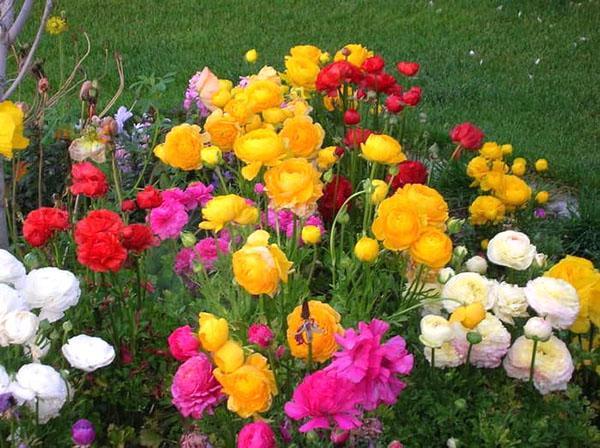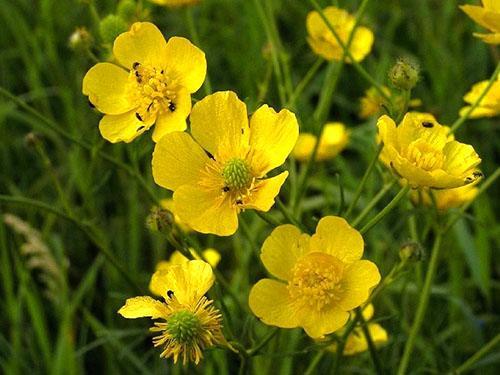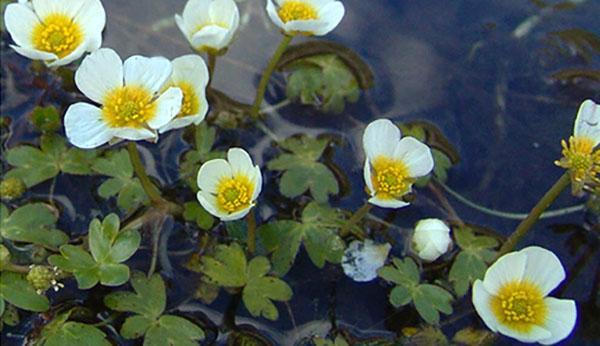Successful cultivation of garden buttercups
 A beautiful flower that came from Turkey (considered a symbol of the Ottoman Empire) has now become a host in ordinary gardens. The cultivation of garden buttercups according to the developed technologies, using the advice of specialists (recommended in the article), has become the hobby of many flower growers.
A beautiful flower that came from Turkey (considered a symbol of the Ottoman Empire) has now become a host in ordinary gardens. The cultivation of garden buttercups according to the developed technologies, using the advice of specialists (recommended in the article), has become the hobby of many flower growers.
The exotic flower Ranunculus (together with numerous legends and myths) appeared in the gardens of Europe in the 16th century. Many hybrid forms have appeared, striking in shape and color. In order to successfully admire the beauty of a flower in the beds, in cutting it is necessary to strictly adhere to the tips for growing and caring for buttercups in the garden.
Description of the garden buttercup
The plant belongs to herbaceous perennial species. Branched bushes covered with dahlia-like leaves grow small (up to 50 cm). The root has a tuberous shape. The size of the flowers reaches 12 cm in diameter for specific species. Now there are many hybrid varieties of garden buttercup, for cultivation and care in an ordinary garden, derived from wild types of buttercup. In natural conditions, botanists have discovered about 600 types of plants. Among them:
- caustic buttercup;
- creeping;
- poisonous;
- field;

- water;

- Kashubian;

- gray-yellow.
Near water bodies, in meadows, in the mountains of various regions of the planet, you can find a beautiful, tenacious plant. The aconitol (borecell) giant (up to a meter in height), covered with snow-white or yellow flowers, can be seen in garden beds.
The most decorative and popular in gardens is Ranunculus Asian, with flowers of varying degrees of doubleness and varied color of petals. Buttercup flowers resemble small roses, peonies, poppies. According to their form, the following types are distinguished:
- Turquoise (African). Dense flowers are in the shape of a ball with petals bent inward (very similar to peonies).

- French. Semi-double view with two rows of petals.

- Persian. The plant is undersized with simple, semi-double flowers.

- Peony. Flowers are double, large. In the climate of central Russia (less demanding on weather conditions), the cultivation of garden buttercups of this type is most popular.

The best garden buttercups include representatives of the Blooming Valley series:
- Double Pink Buttercup;

- Rebecca;

- Purple Picotee.

Growing garden buttercups

Beautiful bushes suitable for cutting, blooming for 5 years, can be obtained by following the rules of cultivation technology, following the advice of specialists. Among them are the following tips on how to plant correctly buttercups, stages of plant care.
Preparing a place in the garden
 Buttercups are planted in spring in a porous, fertile soil with good drainage conditions.
Buttercups are planted in spring in a porous, fertile soil with good drainage conditions.
The landing site for buttercups should not be in drafts, bright sun. The presence of wind, an excess of scorching rays restrain the processes of flowering, seed setting.
The soil is chosen loose with a slightly acidic, neutral acidity value. Before planting buttercups in the spring, it is recommended to add compost, humus. A good landing site is an area with close surface waters that create an (optimal) humid climate. Young shoots appear in 10 - 14 days. If there is a threat of frost, it is recommended to cover them. The time when to plant buttercups in open ground is determined by a steady repetition of positive temperatures at night.When choosing a planting site, one must remember that buttercup flowers contain poisonous compounds.
Watering
 Despite the fact that in nature buttercups grow well in humid conditions, before planting garden buttercups, you need to know that the flower responds equally badly to drought, waterlogging of the soil.
Despite the fact that in nature buttercups grow well in humid conditions, before planting garden buttercups, you need to know that the flower responds equally badly to drought, waterlogging of the soil.
Tubers of garden buttercups quickly rot, die with frequent, abundant watering. They are rescued by digging out of the ground in time, treated with potassium permanganate, and dried.
Plants are watered regularly, in small portions. For effective cultivation, it is advised to close them during heavy rains, to make high-quality drainage at the bottom of the planting holes. During flowering watering reduce. Caring for buttercups after flowering completely eliminates watering. The signal is the disappearance of all buds, the appearance of yellow leaves. Watering is accompanied by weeding, loosening the soil.
Top dressing, fertilization
 Growing and caring for buttercups in the garden will not be effective without properly organized feeding, which gives strength to the young plant. The periods of growth of the seedling, the formation of leaves, the appearance of the first buds are considered to be especially responsible time.
Growing and caring for buttercups in the garden will not be effective without properly organized feeding, which gives strength to the young plant. The periods of growth of the seedling, the formation of leaves, the appearance of the first buds are considered to be especially responsible time.
Carry out top dressing every 10 days using organic, mineral fertilizers.
Maximum application nitrogen do during the period of active growth of bushes. Use the mullein solution when buds appear, and then use phosphorus-potassium fertilizers.
Before feeding, it is advisable to carefully remove dry leaves and inflorescences.
Pest and disease control
 The plant is resistant to many pests that attack flower beds. Excessive watering causes dampness and attracts cabbage butterflies. You can defeat them by using chemicals, folk remedies, similar to caring for a vegetable garden.
The plant is resistant to many pests that attack flower beds. Excessive watering causes dampness and attracts cabbage butterflies. You can defeat them by using chemicals, folk remedies, similar to caring for a vegetable garden.
The problem that leads to the death of tubers is viruses that lead to the loss of flower decorativeness. Experts advise more often (at least at 3.4 years) to rejuvenate the plant with new tubers purchased in the store.
Preparing for winter
 Bushes are actively blooming until the end of August. Further, the plant needs to organize the conditions for preparation for winter storage, the next growing season. In mid-September, the plants are dug up, dried, placed in cardboard boxes, covered with sawdust, peat or moss. Knowing how to store buttercups in winter is essential to getting quality material for the next season.
Bushes are actively blooming until the end of August. Further, the plant needs to organize the conditions for preparation for winter storage, the next growing season. In mid-September, the plants are dug up, dried, placed in cardboard boxes, covered with sawdust, peat or moss. Knowing how to store buttercups in winter is essential to getting quality material for the next season.
It is necessary to store the tubers at a temperature of + 4 + 6 ° C. Leaving the garden for the winter is possible under the condition of warm winters. The plantings are covered with foil, covered with spruce branches, and other branches.
Cropping flowers
 A useful agrotechnical technique (in growing garden buttercups), which retains the decorative effect of the bush for a long time, is correct pruning. Do it in the following cases:
A useful agrotechnical technique (in growing garden buttercups), which retains the decorative effect of the bush for a long time, is correct pruning. Do it in the following cases:
- Shoots with dried inflorescences are removed. The bush blooms unevenly, you can always see twigs at different stages of development on it. Pruning maintains the beautiful appearance of the bush.
- Garden buttercups work well in bouquets. Modern varieties of the Persian group of plants have long stems and retain their decorative effect for about two weeks.

Cut off the stems in water (the cut should be oblique), remove all the leaves to the water level, constantly add water, tear off wilted inflorescences, bud, do not keep the bouquet in a draft.
Reproduction of buttercups
 Now it is easy to buy a ready-made tuber, seedling and admire a new hybrid plant variety of any shade, shape. But if you want to go through all the stages of development (plant, carry out care) of a buttercup with garden seeds, then you can use the following information:
Now it is easy to buy a ready-made tuber, seedling and admire a new hybrid plant variety of any shade, shape. But if you want to go through all the stages of development (plant, carry out care) of a buttercup with garden seeds, then you can use the following information:
- Seed propagation of buttercups is considered difficult. Especially if it starts with collecting seeds of a garden buttercup in your own area. It is recommended to remove them from the first strong flowers, which most fully preserve the properties of the mother plant. They tie the flower on the bush with gauze and wait for the seeds to ripen.In February (or early March) they are sown in a container filled with soil consisting of peat, leafy earth, sand (recommended proportions 1: 1: 0.5). The depth of planting seeds is not more than 1 cm. The crops are carefully moistened with a spray bottle. The box is closed with glass, placed in a room with a temperature of about + 12º C. The seedlings will appear in three or four weeks. The container is transferred to a lighter, warmer place (temperature not lower than + 20º C). The seedling is transplanted into separate containers after the appearance of four true leaves. Then comes the time of planting, leaving the buttercup in the open field.

- Growing buttercups from tubers. Buttercup roots, similar to small cones, are planted in open ground in late April, early May. Before planting, they are soaked in a solution of any growth stimulant. They are planted with "claws" to the bottom of the fossa at a distance of about 15 cm from each other. On heavy soils, the planting depth is maintained at about 5 cm.On light soils, it increases to 8 cm.
The process of growing garden buttercups is an exciting experience. The labor expended is rewarded with the beauty of an unusual carpet when the buttercup blooms, delighting the owners even on the most cloudy day.